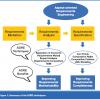 |
Taming the Headless Beast: A Proven Strategy for Testing Web Services The benefits of Web services are becoming widely demonstrated and accepted. However, these benefits are not without their own challenges. How can you enter data and verify the response of a system without a GUI? Are you ready to tame this headless beast?
|
|
 |
Risk-based Testing in Action Risk-based testing allows project teams to focus their limited test efforts on the areas of the product that really matter, based on the likelihood of bugs in those areas and the impact of bugs should they exist. By using risk priority to sequence test cases and allocate test effort, test teams can also increase their chances of finding bugs in priority order and allow for risk-based test triage if necessary.
|
|
|
|
Lucky and Smart Charles Darwin was certainly a great scientist, but his career and his discoveries were also strongly influenced by serendipity and luck. What could this great explorer and scientist teach us about testing?
|
|
|
|
Lessons Learned in Close Quarters Combat Few would think that the tactics employed by military and law-enforcement Special Forces to breach buildings under siege bears any relation to software project teams. After a number of weekends training with ex-military and ex-law-enforcement Special Forces—just for fun—Antony Marcano draws a surprising parallel between the dynamics of modern Special Forces "room-clearing" methods and the dynamics of modern software development teams.
|
|
|
|
Cover or Discover? Excellent testing isn't just about covering the "map"–it's also about exploring the territory, which is the process by which we discover things that the map doesn't cover.
|
|
|
|
The One-Hour Regression Test If a customer asked you to demonstrate to him, within an hour, that your newest software is ready for use, what tests would you run? Are these the same tests that you are now performing in your first hour of regression testing? They should be.
|
|
|
|
Know Where Your Wheels Are Drawing from his experiences while learning to drive, Michael applies lessons he learned from written rules, experiential learning, and the advice of mentors to teaching new testers some valuable skills.
|
|
|
|
Out of the Rut Are you bored? Do feel as if all you do is repeat heavily scripted tests and as a result you aren't learning, discovering new problems, or finding bugs? These nine heuristics can help you get out of your rut and take back control of your testing process.
|
|
|
|
Learning the Hardware Lessons Systems and software aren't just about correctness; they are also about solving problems for people. According to the context-driven software testing movement, a problem isn't solved if the product doesn't work. Michael's experience in a hardware store drives that lesson home.
|
|
|
|
How Much Is Enough?—Exploring Exploratory Software Testing Exploratory testers design and execute tests in the moment, starting with an open mission and investigating new ideas as they arise. But how do we know when to stop? The first step is to recognize that we can't know when we're done, because any approach to answering the stopping question is necessarily heuristic.
|
|

